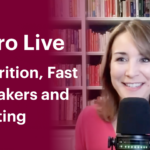Written and medically reviewed by Nicole Grant, RD
For most people, fasting is an excellent tool to improve metabolic health, burn fat, and lose weight; simply fasting for 12–18 hours each day can help you achieve these results. However, if you want to get into Fat-Burning Mode even faster, you’ll want to couple each fast with an intentional pre-fast meal. (Which can make the experience of fasting more comfortable, too!)

Why Is Your Pre-Fast Meal So Important?
In order for your body to optimize its fat-burning ability, it needs to be less dependent on sugar (i.e., glucose) for fuel and more reliant on fatty acids. Fasting influences this “fuel switching,” but so do your food choices within your eating window. The pre-fast meal holds a unique significance compared to other meals because, as the last meal you eat, it directly influences the speed at which you’ll transition into Fat-Burning Mode during your fast. Specifically, the size of your meal and its macronutrient composition, particularly the carbohydrates, can either slow down or speed up the time it takes to optimally burn fat.
Being more conscious with your pre-fast meal can also provide you with a more enjoyable fasting experience. Glucose variability, a.k.a. sugar spikes and crashes, can lead to poorer mood, a decline in energy, and increased hunger. By carefully selecting foods that offer sustained energy release, such as high-fiber carbohydrates, protein-rich foods, and healthy fats, you can help stabilize your blood-sugar levels throughout the fasting period, making your fast feel less like a struggle and more like an empowering act of self-care.
3 Tenets of the Perfect Fast Starter
When it comes to fasting for weight loss and health gain, when you eat is the most important habit to master. Once you’re regularly fasting for at least 12 hours a day, that’s when it’s time to start thinking more seriously about the components and proportions of your pre-fast meal, or Fast Starter. Use these core tenets to maximize the benefits of your fasting experience.
#1) Choose Your Carbohydrates Wisely
Selecting the right carbohydrates in your pre-fast meal plays a crucial role in how effectively you transition from burning predominantly sugar into burning predominantly fat.
When you eat a high-carb meal full of sugar and refined carbohydrates, your body releases a large amount of insulin (a hormone necessary for regulating blood sugar) in response. The more insulin you release, the longer it takes to return to a baseline level — and as long as your insulin remains elevated, your body is less able to tap into stored fats for energy.
In contrast, when you consume modest amounts of high-fiber, low-glycemic carbohydrates, your body’s muted insulin response makes it easier to access and burn stored fats for energy. Thus, you set yourself up for quicker and more efficient fat burning during your fast.
Some examples of ideal pre-fast carbohydrates include non-starchy vegetables like broccoli, zucchini, carrots, and bell peppers; wild rice; legumes; nuts; seeds; and dairy.
#2) Balance Your Plate
While your choice of carbohydrates significantly impacts your ability to optimize your fasting benefits, you still want to be intentional about what makes up the rest of your plate. Protein and healthy fats also contribute to moderating the glucose/insulin response to your meal.
High-protein foods have a higher thermic effect, meaning your body burns more calories digesting and processing them compared to other macronutrients. For example, your body has to invest double the energy to break down a high-protein meal compared to a high-carbohydrate meal. In addition, one study showed that pairing 40 grams of carbohydrates (about 1 cup of cooked rice) with 50 grams of protein (about 6 ounces of chicken breast) reduced the blood-sugar response by about 10% one hour after the meal compared to the carbohydrates alone. In other words, be sure to include protein in your pre-fast meal! The increased rate of caloric burn plus the reduction in blood sugar helps your body transition to Fat-Burning Mode more quickly.
Healthy fats such as olive oil, avocado, and nuts also provide your body with the fuel and nutrients it needs without elevating blood glucose. Similar to protein (although not to quite the same extent), fat also helps blunt the glycemic response to a meal, which can result in less insulin secretion and a quicker entry into Fat-Burning Mode. It also helps you feel fuller for longer, which makes fasting — especially for beginners — more pleasant.
The upshot? Your pre-fast meal should be nutritionally diverse and include both protein and healthy fats to help transition your body into an optimal fasting state as quickly as possible.
#3) Be Mindful of Meal Size
So far, we’ve emphasized that when you eat is most important to master, followed by what you eat (particularly before starting a fast). After you feel comfortable with the when and the what, it’s finally time to assess how much you consume before your fast. The components of your Fast Starter affect how quickly and efficiently your body burns fat during a fast, but so does its size. A larger, calorie-dense meal (one that fills a dinner plate), especially one high in refined carbohydrates, promotes glycogen storage and can lead to a surge in insulin. In turn, this can inhibit your body’s ability to burn stored fat for energy.
Conversely, a small-to-moderate well-balanced meal (think: side-plate- or salad-bowl-sized) that focuses on whole, nutrient-dense foods can maintain more stable insulin and blood-sugar levels. This smaller meal allows your body to metabolize those external nutrients more quickly, thus encouraging it to tap into its own nutrient and fat stores faster.
This way of eating can seem counterintuitive if you’re accustomed to eating your largest meal of the day at dinnertime (i.e., right before you begin fasting). But in order to optimize your body’s Fat-Burning potential, it’s better to flip the paradigm: Eat your smallest meal before your fast and your largest meal when it’s time to break that fast!
Putting It All Together
As you get ready for your fast, work on building a meal that prioritizes protein, healthy fats, and high-fiber carbohydrates. Although any dietary approach can work here, if you want to see optimal fat-burning gains, try to lean more towards a low-carbohydrate or very low-carbohydrate meal immediately before your fast starts. Additionally, serve it in a smaller dish to moderate your caloric intake, which will also help your body enter Fat-Burning Mode faster.
Here are some ideas to get you started:
Example #1
Salmon with pesto, wild rice, and roasted broccoli.
Salmon provides a nutrient-rich protein source, pesto is full of healthy fats, wild rice is a low-glycemic carbohydrate option, and broccoli provides a good source of fiber!
Example #2
Chicken fajitas with sliced avocado and sautéed onions and bell peppers.
Chicken is a great source of protein, avocado provides healthy fat and fiber, and onions and bell peppers are low-glycemic carbohydrate sources with an additional boost of fiber.
Example #3
Tofu and edamame bowl with shredded cabbage and carrots, crushed peanuts, diced avocado, and a ginger miso sauce.
Tofu, edamame and peanuts provide a boost of protein, cabbage and carrots are a great low-glycemic option with added fiber, and the avocado and olive oil used in the ginger miso sauce provide a source of healthy fats.
Conclusion: Every Great Fast Starts with a Smart Pre-Fast Meal
Fasting alone is a powerful method for enhancing metabolic health; however, the efficacy of each fast is deeply influenced by whatever you eat right before starting that fast. Being strategic with this Fast Starter — selecting high-fiber carbs, balancing protein and healthy fats, and being mindful of portion size — can ensure a swift transition into Fat-Burning Mode, leading to a smoother fasting experience and optimal results.
- Why Should We Care About Hormones? Fasting and Hormone Health - April 1, 2024
- Should You Consider a Continuous Glucose Monitor (CGM) If You’re Non-Diabetic? - March 18, 2024
- All About Insulin and Its Effect on Your Weight-Loss Journey - February 19, 2024






